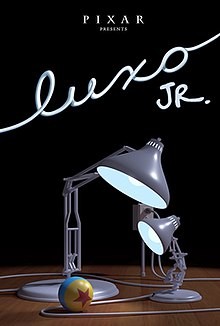| Luxo Jr. | |
|---|---|
 Film poster | |
| Directed by | John Lasseter |
| Written by | John Lasseter |
| Produced by | John Lasseter Bill Reeves |
| Cinematography | Don Conway |
| Edited by | Craig Good |
| Music by | Brian Bennett |
Production company | |
| Distributed by | Direct Cinema[1] |
Release dates |
|
Running time | 2 minutes |
| Country | United States |
Luxo Jr. is a 1986 American animated short film produced and released by Pixar.[2] Written and directed by John Lasseter, the two-minute short film revolves around one larger and one smaller desk lamp. The larger lamp, named Luxo Sr., looks on while the smaller, "younger" Luxo Jr. plays exuberantly with a ball to the extent that it accidentally deflates. Luxo Jr. was Pixar's first animation after Ed Catmull and John Lasseter left the Lucasfilm Computer Division. The film is the source of Luxo Jr., the mascot of Pixar.
Lasseter aimed to finish the short film for the 1986 SIGGRAPH, an annual computer graphics conference attended by thousands of industry professionals. The film would come from his experiments with modeling his Luxo lamp. Lasseter worked to improve the story within the allotted two minutes. In animation, the film demonstrates the use of shadow maps within the rendering software. Lasseter applied the classic animation principles popularized by Disney's Nine Old Men to convey the lamps' emotions. Catmull and Lasseter worked around the clock, and Lasseter even took a sleeping bag into work and slept under his desk, ready to work early the next morning.[3] Ultimately, the film took four and a half months to be completed.[4]
The short film debuted at SIGGRAPH. Before the film finished playing, the audience had already risen in applause.[5] Luxo Jr. is regarded as a breakthrough in the animation industry as a whole, changing traditionalists' interpretation of computer animation. The short was the first work of animation to use procedural animation, the software written by Eben Ostby.[6][7] It received an Academy Award nomination for Best Animated Short Film, becoming the first CGI film nominated for an Academy Award.
The soundtrack music is an uncredited edit of three compositions on Brian Bennett's album Counterpoint In Rhythm: "Finesse", "Quicksilver", and "Chateau Latour".
In 2014, Luxo Jr. was deemed "culturally, historically, or aesthetically significant" by the Library of Congress and selected for preservation in the United States National Film Registry.[2][8]
- ^ "Selected Films For Young Adults, 1988". School Library Journal. 34 (8): 36. April 1988. ISSN 0362-8930.
- ^ a b "New Films Added to National Registry - News Releases - Library of Congress". loc.gov.
- ^ The Pixar Story (2007) (TV documentary)
- ^ Feature: Toy Story: A Triumph of Animation
- ^ Paik, K., Lasseter, J., Iwerks, L., Jobs, S. & Catmull, E. (2007). To Infinity and Beyond!: The Story of Pixar Animation Studios. Chronicle Books. ISBN 978-0-8118-5012-4.
- ^ PIXAR: The Company and Its Founders - Sharyland ISD (page ten) Archived 2014-01-16 at the Wayback Machine
- ^ "Luxo Sr.--an Interview With John Lasseter". harrymccracken.com.
- ^ "Complete National Film Registry Listing". Library of Congress. Retrieved 2020-12-04.